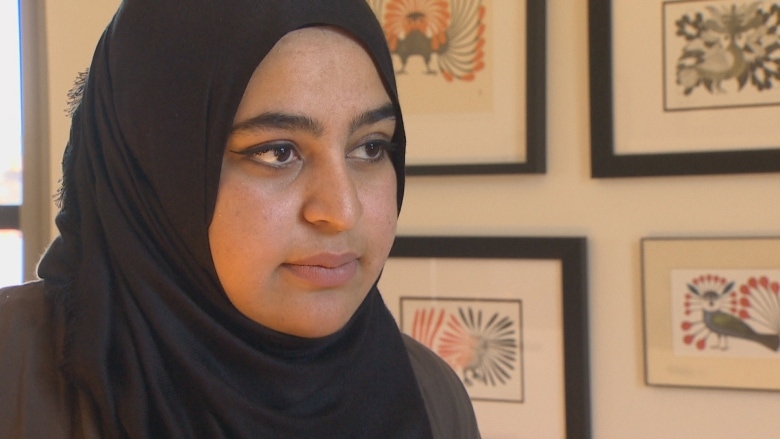Dear Dalhousie University administrators,
I’m writing this letter to express my deep concern for the treatment that Dalhousie student leader Masuma Khan has faced since this past summer. As you may know, much of my research involves the dynamics of racism and colonialism, especially as they implicate white people like myself. Back in 2016, I was invited by the organizing committee of the Dalhousie Arts and Social Sciences Society to deliver the keynote address at their annual conference. I gratefully accepted the invitation, and on March 11, I delivered a lecture entitled, “White Fragility and the Politics of Racism on Campus” to a crowd of about 30 dedicated undergraduate students. They posed difficult questions, I answered as best I could, and we had about 45 minutes of collegial and generative discussion.

Given the remarkable treatment that Masuma now faces at a Dalhousie disciplinary hearing, should I expect that discussions about racism, white fragility, and especially, of white people’s roles in upholding racist structures in our society are now off-limits? Should I counsel students at Dalhousie not to critique social institutions or practices, or not to invite academics who may do so, for fear of reprisals on the part of Dalhousie University, lest a student file a complaint that actually affirms the analysis in question? These developments are quite concerning, and dozens of my colleagues across the country and I who work in critical race theory are following them with consternation.
I have included an abridged version of my lecture from 18 months ago. I invite you to read it, and consider the damage that this effort to shame and punish Masuma may have on your university’s reputation. I also encourage you to consider – should your institution continue to deem it fair to discipline Masuma – that you also discipline me for the words I shared with your undergraduate students last year.
White Fragility and the Politics of Racism on Campus
I’d like to thank Katie, Taylor, and the organizing committee for inviting me to speak here today at DASSS’s annual conference. Taylor and the rest of the organizing team have been extremely professional over the course of the past couple months; so much so that I’d say it’s likely my best experience as an invited speaker over the course of the past few years. They’ve been clear about their expectations and generous with their time and encouragement. As a university professor, I continue to believe that students are capable of quite amazing accomplishments, and this year’s DASSS conference is a testament to this. Thank you.
[…]
What I’d like to do tonight is speak about the continued racist operation of Canadian universities, including this one here, and others in the city and region. I’m going to go through a few theoretical approaches to understanding racism, as well as a variety of sources of data assembled through interdisciplinary methods. My hope in doing so is that I can bring home how the very institutions in which we create knowledge are deeply hobbled by their systematic exclusion of non-Eurocentric knowledges and non-white peoples.
Of course, it’s one thing to assert such a claim, it’s an entirely other thing to present a compelling analysis that supports it. In Canada, we are taught that we are a multicultural paradise of which the world has never seen before: one where racism is a thing of the past and as such, we’re much better off never talking about it, let alone thinking about its continued effects. In other words, making a case about racism is a challenge; a challenge that we as researchers must embrace.
[…]
My colleague Malinda S Smith, who was recently awarded the Canadian Association of University Teachers’ Equity Award for her lifetime commitment to racial and gender equity on campus, recently compiled a list of university leaders according to race and gender at the fifteen largest university campuses in Canada, including at Dalhousie. Please keep in mind that these are figures from 2016, at a time when so-called “diversity” initiatives on campus are at an all-time high, and in a context where it’s common in Canadian society to promote the idea that there is such a thing as “reverse racism”, whereby white men like me are said to be at a distinct “disadvantage” – again, wait for it “white men are at a disadvantage” – due to our society’s purported commitment to multiculturalism and diversity.
In 2016, Presidents at 13 of the largest 15 universities are white. That corresponds to about 87%.
In 2016, 100% of the Provosts or Vice Presidents (Academic) are white at the 15 largest universities.
In 2016, 87% of the Vice Presidents (Research) are white.
That means that 91% of upper administration at the largest Canadian universities are white. Keep in mind that around 25% of the Canadian population identifies as racialized and/or Indigenous, and the Canadian university student body is in the range of 35-40% non-white.
To continue, in 2016, 22 of 23 Deans of Law Schools, or 96% of them, are white.
In 2016, 55 of 59 Business School Deans, or 93% of them, are white. So, given these statistics, we could fairly say that at Canada’s 15 largest universities, around 93% of its top administrators are white, at a time when student bodies at these same universities are no more than 65% white.
To add to these statistics, research published in the Canadian Ethnic Studies journal in 2012 explains that since the adoption of the Federal Employment Equity Act in 1991 […] the proportion of racialized and Indigenous faculty has actually decreased at Canadian universities. Imagine that, during a period in which we are told we conquered racism in society through a commitment to a vacuous multicultural ethics, our university students, who have definitely become more racially and nationally diverse, are being taught by a higher proportion of white faculty members.
In other words, while the proportion of racialized and Indigenous students at Canadian universities has increased over the past 20 years, the proportion of white people running universities, teaching students, and creating knowledge has also increased.
[…]
Let me add to the mix several other forms of “evidence” of the problem of racism on campus.
For example, Anthony Stewart, a former faculty member at Dalhousie, has written two very compelling books about his experiences of racism, and especially, the resistance to change here; Malinda Smith, a political scientist at the University of Alberta, has dedicated the last decade of her university career to writing report after report about how racism works in post-secondary institutions in Canada; Patricia Monture, formerly a sociologist at the University of Saskatchewan, wrote two books and several articles and chapters about the same issues and how they impacted her as an Indigenous student and professor. There are literally hundreds of examples of quantitative, qualitative, legal, sociological evidence brought forth by Indigenous and racialized students, faculty, and staff documenting how racism works institutionally as a form of violence.
[…]
All of this is relatively straightforward. Yet, it remains virtually impossible for anybody in our institutions, to acknowledge the existence of racism, let alone talk about it productively and work to transform its dynamics. How can we explain this rather troubling phenomenon on our campuses, one that results in the consolidation of white power during the same period that white people increasingly perceive themselves to be at a disadvantage?
The theoretical concept I alluded to earlier has been developed by Robyn DiAngelo and is called “white fragility”. Basically, DiAngelo argues that white people in North America live in a social environment that insulates us from race-based stress. This social environment builds an expectation of racial comfort, which reinforces our relative inability to tolerate race-based stress. White fragility is the state in which even a minimum of racial stress becomes intolerable, triggering a range of defensive moves. My argument herein uses DiAngelo’s concept to explain how we’ve arrived at such a dismal state of affairs on Canadian campuses.
To be clear, what DiAngelo is identifying is a white problem, i.e., a problem with how white people – men, women and everybody in between or outside these gender identities – are emotionally invested in maintaining the status quo racial order. Over the past few years I have witnessed how white people like myself will do just about anything to avoid any questioning of their conduct when it comes to institutional racism. I had always understood this on an intellectual level, but I had never been exposed to it on quite the same emotional level. Before we can make any institutional change, I have come to believe that we must address white people’s emotional investment in the status quo. The means through which my white peers and our bosses are willing to go to deny, minimize, deflect, project, dismiss, and anything else it might take to avoid just having a conversation about racism, let alone make any change, is stupefying.
The types of conduct common to white fragility have one primary function: to reinstate white racial equilibrium. DiAngelo outlines several examples of how white racial comfort can be disrupted:
- Suggesting that a white person’s viewpoint comes from a white frame of reference, and not an objective, universal position (challenge to objectivity);
- People of colour talking directly about their experiences of racism (white racial expectations and need/entitlement to racial comfort);
- A fellow white person not providing agreement with established white norms (challenge to white solidarity);
- Suggesting that racial group membership is significant (challenge to individualism);
- Acknowledging that access is unequal between racial groups (challenge to meritocracy);
- Presenting people of colour in a position of leadership (challenge to white authority).
DiAngelo explains that, “In a white dominant environment, each of these challenges becomes exceptional. In turn, [white people] are often at a loss for how to respond in constructive ways. [White people] have not had to build the cognitive or affective skills or develop the stamina that would allow for constructive engagement across racial divides.”
[…]
The most amazing part of White fragility, and I’m more than willing to accept that it operates on a relatively subconscious level, is that is makes the person or people with the claim about racism out to be the problem! And since our institutions are dominated by the white fantasy that racism is no longer a problem – what Eduardo Bonilla-silva has called “colour-blind” racism or “racism without racists” – the substantive matters are never addressed since the focus moves to mending white people’s hurt feelings. You’ve heard me right, the person expressing concerns about racism is often more likely to be taken to task for disrupting white comfort than to have their message about racism fully considered. And that is what I’m suggesting is currently occurring on campus in Canada: white fragility is the primary strategy in maintaining white dominance in our public institutions of higher education.
Can you imagine that? The large majority of white people at our universities are so emotionally invested in maintaining a racist status quo that they feel victimized by those who raise their concerns about the workings of racism! It’s an incredible development, one that has taken the past 30 years or so to develop as a publicly acceptable defense of white supremacy. The ultimate insult is that those who have risked their well-being and employment by coming forward are put in a situation in which they must either apologize to the same people who have been benefitting from the status quo racial order or leave.
[…]
Just so that I’m clear, I think it’s possible and necessary to understand and intervene in the structures of feeling that we as white people have developed to experience comfort with an incredibly inequitable racial order. But in order to do so, we must refuse the comfort – the first impressions, the friendly nods, the knowing laughter, the appeal of familiarity – that is often exclusive to whiteness or white culture. At the very least in our professional roles, we must learn to embrace discomfort, for all the richness it brings.
[…]
I’ve come to the conclusion that as white fragility develops into a primary mode of consolidating white power in our society, as evidenced by the troubling statistics and the anecdotes I shared with you earlier, white people solidify an inability to empathize with racialized and/or Indigenous people in our society who experience a disproportionate amount of poverty and everything that is associated with it because of racism. In other words, we are meant to care about the suffering of white people like us in society in a regular, patterned, at times predictable manner, to the detriment of racialized, especially Black, and/or Indigenous people.
Our inability and unwillingness to be exposed to racial stress ensures that as white people we have been taught to care less about, and consequently, to devalue the lives of indigenous and Black peoples. We are generally more immune to their suffering. We have even developed very sophisticated ways for understanding that suffering as unrelated to us, to our choices, our conduct, our policies, our laws. But remember, if we are to take the idea of white fragility as a way to explain a phenomenon like the overwhelming whiteness of Canadian university life, then our very comfort as white people depends on our ability to minimize, deny, or ignore the stories we encounter that may in fact point to racism in some way. Our ability to create white space depends on its disavowal after all, an impressive feat. And yet, the feat itself is rather pedestrian, the stuff of everyday life on campus.
And this is the message I bring to you today, since many of you are future elites in our society: leaders of human rights and social justice organizations, political parties and associations, government bureaucracies, lawyers, writers, and even, in some cases, professors. There’s a tendency to want to put a pretty bow on these types of discussions, to wrap it up in a way that leaves us with a sense of hope or at the very least, some ways forward. I’m going to resist that compulsion, primarily because I believe that as white people, we must feel the type of discomfort that only comes with openly and uncompromisingly disrupting the consolidation of white power currently occurring in our very midst.
Darryl Leroux is Associate Professor in the Department of Social Justice and Community Studies at Saint Mary’s University. His work examines the racial dynamics of whiteness, including most recently through a project that looks at the phenomenon of white settler self-indigenization. His work is available here.
If you can, please support the Nova Scotia Advocate so that it can continue to cover issues such as poverty, racism, exclusion, workers’ rights and the environment in Nova Scotia. A pay wall is not an option, since it would exclude many readers who don’t have any disposable income at all. We rely entirely on one-time donations and a tiny but mighty group of dedicated monthly sustainers.



